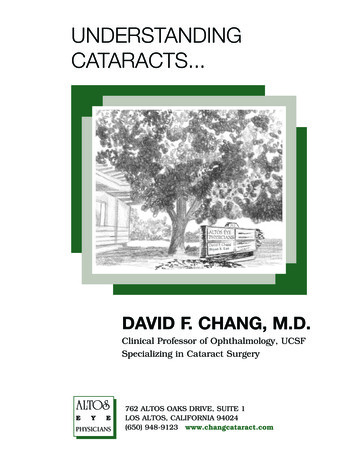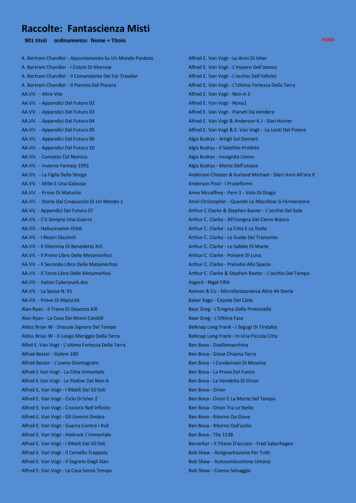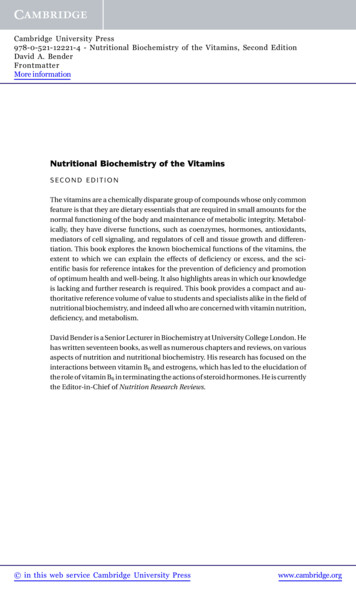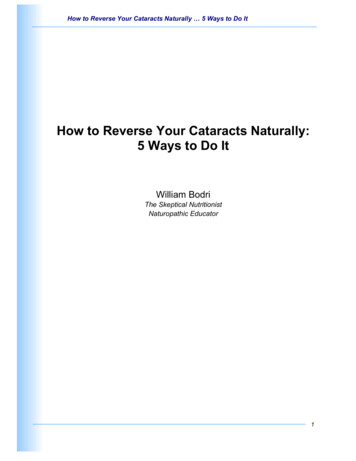
Transcription
UNDERSTANDINGCATARACTS.DAVID F. CHANG, M.D.Clinical Professor of Ophthalmology, UCSFSpecializing in Cataract Surgery762 ALTOS OAKS DRIVE, SUITE 1LOS ALTOS, CALIFORNIA 94024(650) 948-9123 www.changcataract.com
IntroductionBecause cataracts are so common, and becausecataract surgery is my specialty, I have writtenthis booklet for patients to answer commonlyasked questions about cataracts. Althougheach individual’s condition may differ, advancesin cataract surgery continue to benefit morepatients than ever before.I hope that this information will help you tobetter understand your situation, and to view itwith less apprehension.Normal eyeWhat is a cataract?A cataract is a clouding of the normallytransparent lens within the eye. It is not agrowth or a film that can be peeled off. Locatedinside the eye, cataracts cannot be seen withouta special microscope. Thus, they do not changethe appearance of the eye; they do not causediscomfort. Changes may be so gradual thatyou are not aware of a cataract’s effect at first.Simulated advanced cataractCataracts are the most common cause ofblurred vision over the age of 50. Although thereis no medicine or diet to cure cataracts, surgicalremoval of the cataract and replacement witha permanent artificial lens implant can restorelost vision.How does the eye work?The eye functions very much like a camera.Light enters through the cornea - the clear front“window” of the eye. In order to reach the backof the eye, it passes through the pupil, which isthe hole in the iris. The color of our eyes (blue,brown, hazel) is really the color of the iris seenthrough the transparent cornea.Immediately behind the pupil is the naturallens of the eye. Just as a camera lens focuseslight onto film at the back of the camera, thehuman lens focuses light onto the retina, thethin layer of tissue lining the back of the eye.Like camera film, the retina forms the “picture”which is then relayed to the brain along theoptic nerve.Clear LensCloudy Lens(cataract)
What causes blurred vision?When should cataractsbe removed?Just as fingerprints on a camera lens causeblurred pictures regardless of our efforts tofocus, a cloudy lens within the eye causesblurred vision. When the human lens becomescloudy or hazy enough to interfere with vision,it is called a cataract. Changing glasses (focus)will not help the blur that is caused by acataract.The decision to have cataracts removed iselective. Because cataracts do not harm otherparts of the eye, nothing needs to be done if youare not significantly bothered by symptoms.However, as activities such as driving andreading become increasingly affected bycataracts, surgery becomes a logical option toconsider.Just as defective film will spoil photographs, aweak retina (as in a condition called maculardegeneration) will cause blurred vision in eyesdespite a clear lens and proper focus (glasses).Good vision always requires (1) optimal focus- usually with glasses, (2) a clear lens, and (3)a healthy retina.With the success of the modern implant,waiting for cataracts to “ripen” is no longernecessary. Since cataracts will not improve andwill eventually worsen, there is no advantagein delaying treatment if vision is sufficientlyaffected and the prognosis of surgery is good.You are never “too old” to have cataract surgery,just as you are never “too old” to enjoy bettervision.What are the symptoms?What is a “lens implant”?Cataracts cause visual symptoms only; they donot cause pain, discomfort, tearing, or redness.The visual symptoms can vary. Blurriness, hazyvision, or increased glare from sunlight andheadlights may be present. Some cataracts turnyellow, causing fading of color. Reading maytake more effort, and you may tire prematurely.Vision progressively worsens over a period ofyears or sometimes after only a few months.What causes cataracts?Some cataracts are caused by birth defects,injuries, diabetes, or prolonged use ofcertain medications, such as steroids. Highlynearsighted patients may develop cataracts ata young age. However, most cataracts resultsimply from the natural aging process of thehuman lens. Like gray hair, cataracts are not adisease, nor do they occur at the same age orrate in everyone.To take the place of the clouded humanlens, a tiny, delicately engineered artificiallens is implanted into the eye. The modernintraocular lens "implant" does not change theappearance or sensation of the eye. The implantis permanent. Unlike a contact lens, it cannotfall out and does not require cleaning.The "prescription" or power of each patient’simplant is selected based on computercalculations that use a series of precise eyemeasurements performed in the office prior tosurgery. The distance between the front of theeye and the retina can be measured preciselyusing precise optical methods. This painlesstest is called biometry.Newer implant designs that can decreaseyour dependence upon glasses have becomeincreasingly popular. However, they are notappropriate for all individuals, and the additionalcost is not covered by health insurance. Duringyour consultation, I will determine and explainwhat the best options are.
How is surgery performed?Cataract surgery is microsurgery; it utilizes anoperating microscope and is performed insidethe eye through an incision. One can think ofthe human lens as having a thin, transparent“wrapper” which holds the lens in the centerof the eye. This delicate, cellophane-like skinis called the lens “capsule.” A hole is made inthe front of this wrapper, and the cloudy lensis removed in several delicate stages, leavingbehind an empty clear capsule. The implantis then inserted into this empty wrapper,occupying the original place of the natural lens.Capsule “Wrapper”Older method (large incision)Fragmentation method (small incision)Empty CapsuleCapsule
What is “small incision”cataract surgery?Removing the solid core of the cataract as a singlepiece requires a large incision with multiplesutures. Physical activities must be limited toavoid straining the large incision, which takesseveral months to stabilize. Since enteringpractice in 1984, Dr. Chang has routinelyperformed the most advanced techniquesof “small incision surgery” using specializedtechnology called phacoemulsification.The firm cataract core is fragmented intosmall particles that can be gently sucked outthrough a tiny 2.5 mm incision (1/8 inch).Modern foldable lens implants can fit throughincisions this small, and sutures and bandagesare not required. Physical activities are notrestricted after small incision surgery, and thevision stabilizes faster than with large incisionmethods.Conventional largeincision closedwith 8 or 9 sutures.(See stitchesabove iris).Incision is muchsmaller when insert inga fold able intra ocularlens followingphaco emul si fi ca tion.(Incision is placedon side edge of cornea).NOTE: Dr. Chang personally performsall of his own cataract surgeries. Beingin private practice, there are no traineesperforming any part of the procedure.What are the risks ofcataract surgery?There is some risk with any surgical procedure.For each patient, I carefully weigh the risk/benefit ratio by imagining what I would do if Iwere in your place. Fortunately, in experiencedhands, severe complications that could worsenthe vision are rare. The chances of eyelid,cornea, retina, and ocular pressure problemsmay depend on individual circumstances, but allmay occur even without surgery - i.e. with agingalone. With modern advances in technique, wecan be very confident that otherwise healthyeyes will gain significant visual improvementfollowing surgery.What is the experienceof surgery like?Your outpatient surgery will be performedat the Peninsula Eye Surgery Center, 1128W. El Camino Real, in Mountain View, CA,(650) 964-3200. This was the first surgerycenter in the San Francisco-San Jose regionto specialize in eye surgery only, and performsone of the highest volumes of cataract surgeryin Northern California.Dr. Chang was among the first in the Bay Areato employ topical or “needle-free” anesthesiafor cataract surgery. The eye is numbed byanesthetic drops, rather than the conventionalshot of Novocaine. Thanks to light sedation,you will feel calm and relaxed, but awake.Since your lids are gently held open, you willsee light, but not the operation itself. This mostadvanced method eliminates sutures, anestheticinjections, eye bandages, and postoperativerestrictions for most patients. Since the surgerytakes less than 20 minutes, even patients inpoor health can successfully undergo cataractsurgery.
What is the recovery likefollowing surgery?You will receive detailed written instructionson care after the operation. An eye bandageis not necessary when topical anesthesia isused. The eye surface may feel scratchy at first.With small incision surgery, you may resumeeveryday activities and physical exercise assoon as you like.As with any surgery, the healing period willvary with each individual. Use of the eye is notharmful, but the vision is normally blurry atfirst. Your eyeglass prescription will be differentafter surgery and will be changed approximatelyone month later.FAQ about artificial lens implantsDoes the artificial lens replace the need forsunglasses?Sunglasses provide two benefits. Dark tintingreduces brightness, and a transparent UVcoating blocks out the invisible, but harmful,ultraviolet rays of the sun. Because all modernartificial lens implants contain this UV coating,they provide ultraviolet protection at all times.However, since implants are not darkly tinted,patients may still choose to wear sunglasses forcomfort, just as they did before their cataractsurgery.If I previously had LASIK or other refractivesurgery, can I still have a lens implant?Yes. However, prior refractive surgerysignificantly impairs the accuracy of cornealmeasurements, making it very difficult toestimate the optimum implant power. A newer,but very expensive type of lens implant - thelight adjustable lens - solves this problembecause we are able to precisely change andadjust the lens prescription using a UV lighttreatment after we surgically implant it.In conclusionHelping patients regain vision they have lost isone of my most gratifying experiences. Thanks tothe many advances in ocular microsurgery, wecan safely restore excellent vision to most peoplewith cataracts. More than 3 million Americansenjoy the benefits of renewed sight throughcataract surgery annually. I hope this materialhas been both interesting and reassuring toyou. There is much more additional informationon my www.changcataract.com website,including information about the different lensimplant options.Does cataract surgery mean that I won’tneed glasses anymore?Not exactly. While we are young, our internaleye muscles change the shape of the naturalhuman lens to move our focus from far to near,and back. This natural focusing ability presentin young eyes is called accommodation. Dueto a loss of lens flexibility with age, we all losethis ability to automatically change focus by thetime we reach our mid-forties. This re-focusingfunction must be replaced with reading glasses,bifocals, or trifocals.Conventional artificial lens implants are singlefocus or “monofocal” lenses. Like the olderhuman lens, they cannot change focus from fardistance to near. Following cataract surgery,although many activities may be fine withoutglasses, patients are able to choose from thesame options available to everyone else over theage of 50 – contact lenses, bifocals, or separatedriving or reading spectacles - to optimize theirfocus at different distances.There are more advanced artificial lens implantsthat can reduce (but not totally eliminate) yourneed for eyeglasses. Multifocal lens implantsare designed to provide focus at multiple zones– far, intermediate, and near. Patients withmultifocal lenses generally wear glasses theleast often, but they should have perfect eyehealth and no problems with the retina orcornea. Multifocal lenses produce halos around
lights at night that become less noticeable overtime for most patients. Extended focus lensimplants provide greater focusing range thana monofocal, but not as much as a multifocallens. Patients with extended focus or multifocallens implants generally don't need progressivebifocal or trifocal glasses; they typically justcarry reading glasses.Will these special lens implants eliminatemy glasses altogether?This is unlikely. Most people with multifocallenses still find it easier to read with glassesunder certain conditions. However, comparedto conventional monofocal lenses, multifocallens implants generally provide the convenienceof reading many things (e.g. your mail, pricetags, handouts, menus, and a wristwatch orcell phone) without having to put on readingglasses. With reading glasses on, you shouldsee equally well with all of these lens implants.Using any of these special lens implantsdoes not change the surgery or recovery rate.Like conventional lenses, the multifocal andextended focus implants are foldable lensesthat are implanted through a small incision andare equally safe.What about the cost?Health insurance, such as Medicare, covers thecosts of cataract surgery with a basic monofocallens implant. Not surprisingly, the multifocal ortoric lens implant procedure is more expensive,and the additional costs must be paid outof-pocket by the patient. Remember that thebenefits of these more advanced lens implantsare to reduce the inconvenience of havingto wear eyeglasses as frequently. They arenot “medically necessary” because they havenothing to do with improving your eye health.Reducing the need to wear glasses is not apriority for everyone and may therefore not beworth the added expense. All artificial lensesshould provide equally good vision with glassesfollowing cataract surgery. The difference isin what you can see when you aren’t wearingglasses.You may also need eyeglasses to correct oroptimize your far distance vision followingcataract surgery. The artificial lens comes inmore than 60 different powers. Since there isno opportunity for trial and error in selectingthe lens implant for your eye, “perfect”distance focus is not necessarily achievedwith surgery. Astigmatism is another reasonthat distance glasses may be needed attimes. Fortunately, eyeglasses can be usedto optimize distance focus just as they do foranyone whose eyes are not in perfect focusnaturally.Can Astigmatism be reduced with cataractsurgery?Like nearsightedness, astigmatism describesa common type of blur in healthy eyes thatis corrected by wearing eyeglasses. It resultsfrom an inherited, imperfect optical shapeof the cornea, the clear front window ofthe eye. This causes a natural misfocus orblur (astigmatism) that requires prescriptioneyeglasses for the clearest vision.Although it has nothing to do with cataracts,astigmatism can be reduced or possiblyeliminated at the same time that cataractsurgery is done. For small amounts, theastigmatic keratotomy technique placestiny superficial incisions that do not enterthe eye, but reduce the undesirable oblongshape of the cornea. The most commonmethod is to permanently incorporate theastigmatism correction into the artificiallens implant, rather than relying onprescription eyeglasses after surgery. Thisbuilt-in feature is called "toric" and can beadded to any monofocal, extended focus, ormultifocal lens implant. The light adjustablelens also corrects astigmatism, and maybe particularly advantageous for patientswho are accustomed to "monovision" withcontact lenses or following LASIK.Alloftheseastigmatism-correctingtechniques allow appropriate patients to seebetter when they are not wearing eyeglasses,and any eyeglasses worn will be less strongas a result. They are perfectly safe anddo not require the cataract surgery to beperformed any differently; however, they doinvolve additional costs.
AboutDr. ChangDavid F. Chang, M.D. is widely recognized as one ofthe top cataract surgeons in the world. He graduatedSumma Cum Laude from Harvard College and earnedhis Medical Degree from Harvard Medical School.Dr. Chang completed his ophthalmology residencyat the University of California, San Francisco, wherehe advanced to the rank of Clinical Professor ofOphthalmology in 1999. He has taught cataract surgeryto ophthalmology residents in training for more than 35years.As an internationally recognized cataract expert, Dr.Chang regularly lectures on cataract surgery to othersurgeons in the U.S. and abroad. Dr. Chang hasreceived the highest international awards for cataractsurgery from the American Academy of Ophthalmology(Kelman Medal Lecture) and the following internationalcataract and refractive surgery societies: American(Binkhorst Medal), Canadian (Award of Excellence),United Kingdom and Ireland (Rayner Medal), German(DOC Innovator Lecture), Indian (Gold Medal), and the Asia Pacific Association of Cataract & RefractiveSurgery (Lim Medal). He has been honored by the International Society of Refractive Surgery (PresidentAward), American-European Congress of Ophthalmic Surgery (Visionary Award), All India OphthalmologySociety (President’s Lecture), Italian Ophthalmological Society (Strampelli Medal), Chinese AmericanOphthalmological Society (Pioneer Award), Royal Australia & New Zealand College of Ophthalmologists(Gregg Medal), Asia-Pacific Academy of Ophthalmology (Jose Rizal International Medal), InternationalIntraocular Implant Club (IIIC Medal), Middle East Africa Council of Ophthalmology (El-MaghrabyAward), and the International Council of Ophthalmology (Krwawicz Gold Medal). Including these, Dr.Chang has delivered more than 40 named lectures.Having served as president in 2012-2013, Dr. Chang is on the executive board of the American Society ofCataract & Refractive Surgery (ASCRS), the largest international organization for cataract and refractivesurgeons. He chaired the American Academy of Ophthalmology (AAO) Cataract Preferred PracticePattern Committee. This select national committee writes the clinical guidelines for cataract surgerythat are used in the United States and in many foreign countries. Dr. Chang is also a leading experton global cataract blindness. He co-chairs the ASCRS Foundation and received the prestigious AAOHumanitarian Service Award in 2019.Dr. Chang has authored 5 best-selling textbooks on cataract surgical techniques for ophthalmologists.Mastering Refractive IOLs covers advanced lens implants and is considered the most comprehensivetextbook on the subject. He has served as Chief Medical Editor of EyeWorld, a leading trade journalwhich has a global circulation of more than 30,000 ophthalmologists. Dr. Chang has designed a numberof popular cataract surgical instruments that bear his name and are used worldwide. As a clinicalinvestigator, Dr. Chang was the first American surgeon to implant the light adjustable lens implant andthe first Northern California surgeon to implant a multifocal lens and the Symfony extended focus lens.Dr. Chang has been regularly voted by his peers into the national edition of Best Doctors in Americaand is listed by Beckers Review as one of the top 39 ophthalmologists in the United States. He wasvoted the 5th most influential ophthalmologist in the world by the international readership of TheOphthalmologist. He has maintained his private practice in Los Altos since 1984 and developed andfounded the Peninsula Eye Surgery Center, which opened in 2005. He limits his practice to cataract andintraocular lens implant surgery.
DAVID F. CHANG, M.D. Clinical Professor of Ophthalmology, UCSF Specializing in Cataract Surgery 762 ALTOS OAKS DRIVE, SUITE 1 LOS ALTOS, CALIFORNIA 94024 (650) 948-9123 www.changcataract.com. . NOTE: Dr. Chang personally performs all of his own cataract surgeries. Being
![No, David! (David Books [Shannon]) E Book](/img/65/no-20david-20david-20books-20shannon-20e-20book.jpg)









